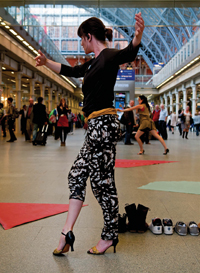How do ‘accidental audiences’ for art in public spaces experience performances and what impact does it have? Richard Turpin examines the evidence

Over recent years site-specific and pop up events have become increasingly common ways for cultural organisations to develop their offer and find new ways to engage audiences. With this shift to non-traditional spaces there has been an associated change in the relationship between audiences and performers. A key part of this change has been the concept of what it means to be an ‘accidental audience’ member; someone who chances upon a performance without any prior knowledge or expectation of what it involves. As a passer-by, how does it affect your experience of art to have it thrust upon you? And for us practitioners, what can we learn about using this type of approach to engage new audiences and how can we best collect information and report on this?
Last summer, Audiences London set out to investigate these questions. In a project commissioned by a group of eight London boroughs, we worked with dance company Bottlefed to develop a pop up performance piece with evaluation at the core. The resulting contemporary dance piece, ‘Meet me Far from Gravity’ was performed at 13 outdoor locations across London, ranging from a bus stop in the City to a supermarket entrance in Surrey Quays. Various techniques were used to investigate the audience experience and to place this into context of their geo-demographic profile and previous engagement in contemporary dance.
From the research we identified three key stages that a passer-by went through before they became an audience member. The performance had to capture their interest, they needed ‘permission’ to view and their interest had to be maintained.
- Capture interest – The research showed that people need cues to help them understand what is happening and whether it is for them. In an area with high footfall, people make decisions in a ‘split second’ as they pass by, based on information available.
- Permission to view – Once you have captured their interest a person is likely to stop and assess what you are doing and decide whether it is of further interest to them. At this stage it is important to feel that they have ‘permission to view’, to be confident that this is directed at them and that they are not a bystander in someone else’s activity.
- Maintain interest – After deciding that the performance is directed at them, the potential audience member will make an assessment of whether the content is of interest to them and also what expectations there may be of them, for example; will they need to interact with the performers? Will they be asked for money at the end?
Our research also showed that there were two factors that had a particular influence on the audience member’s perception of these stages. The first factor was the perceived ‘call’ on their time; essentially whether the person felt that they had enough time to stop and watch. We observed a real difference between locations and times of the day. At a transport hub during rush hour, for example, the proportion of people who stopped was much lower than in a public square at lunchtime. The second factor was the presence of other audience members. People felt more comfortable and were much more willing to engage when they were watching as part of an existing audience.
Overall we found that the audiences that engaged with Meet Me Far From Gravity were generally new to this type of work and were not frequent performing arts attenders. However, when we asked them to comment on the performance experience, it was interesting to note how many were able to clearly articulate what they thought of the piece and the nature of their experience.
Taking the performance into the public realm not only stripped away some of the traditional barriers to engagement, but it also gave people confidence to voice their opinions. Many of their comments contained references to how the performance was interacting with the specific location. It was also common for them to describe the experience in terms of how it had taken them outside their normal routines. These accidental audience members had found it both an accessible and a personal experience.
The Meet Me Far From Gravity project has provided some clear pointers to be considered when developing similar work in future. When planning an event, consider how you will capture the interest of passers-by, give them permission to view and maintain their interest; remember that the accidental audience member comes to the performance with nothing, so you may need to provide information cues and prompts to help them to understand the nature of what they are watching; and when scoping your location, think about it from the point of view of audience dynamics as well as how it will work for your performers.
In short, be clear what it is that you want from your audiences and ask yourselves some questions about what type of experience you are trying to create. Put yourself in the audience’s shoes.
An unexpected positive from the project was the rewarding process of working with the dance company to develop a research framework that was truly embedded in the performance. This close working relationship continued ‘on the ground’ as researchers and performers supported each other in a process that always contained an element of chance, with new locations, new audiences and the vagaries of the weather to contend with.
‘Meet Me Far From Gravity’ was commissioned by the central London Boroughs of Camden, City of London, Islington, Lambeth, Royal Borough of Kensington and Chelsea, Southwark, Wandsworth and Westminster and supported by Arts Council England.
The full project report can be downloaded from www.audienceslondon.org



